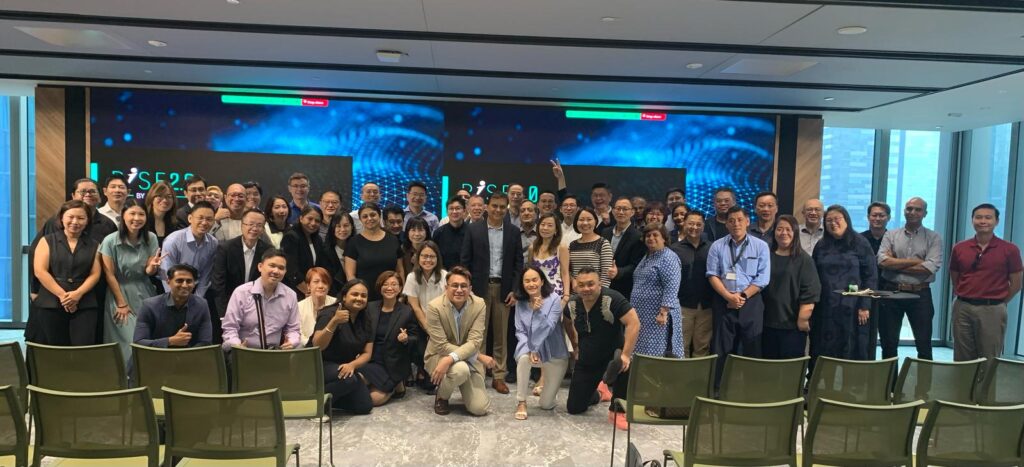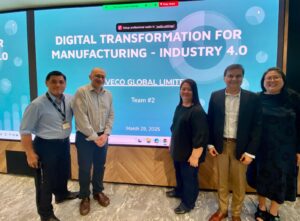In today's volatile, uncertain, complex, and ambiguous (VUCA) environment, the ability to adapt and evolve is not just an advantage—it's a necessity. The rapid pace of technological advancements and shifting market dynamics demand that individuals and organizations embrace digital transformation to not only survive but to thrive. Recognizing this imperative, I embarked on a transformative learning experience with the Digital Transformation & Change Management (DTCM) program offered by RISE by BCG U, a journey that culminated in a challenging yet rewarding capstone project. This blog post chronicles my key learnings from the program and delves into the intricacies of a real-world digital transformation challenge I tackled, highlighting the critical role of DTCM in today's business landscape.
RISE DTCM Program
The RISE DTCM program provided a robust foundation in both digital technologies and the strategic management of change [Overview of the program's scope]. The "biz-tech" skilling approach emphasized not just theoretical knowledge but also practical application through real company projects.
• Building Essential Business Skills: The program instilled core business skills, including structured problem-solving using frameworks like SCQ (Situation, Complication, Question) and Hypothesis Trees, and effective business communication employing the Pyramid Principle and Storylining. An introduction to agile methodologies provided a crucial understanding of iterative and flexible project management.
• Exploring the Digital Landscape: The curriculum delved into the fundamentals of key digital technologies:
- An introduction to Artificial Intelligence (AI) and Machine Learning (ML) explored their potential to drive business value across various industries.
- The importance of data analytics for informed decision-making was emphasized, providing insights into how data can be leveraged for strategic advantage.
- Human-Centered Design (HCD) principles were introduced, highlighting the significance of understanding user needs in developing digital solutions. Tools like user research, affinity diagramming, and journey mapping were explored.
- The program provided an overview of disruptive technologies such as cloud computing, the Internet of Things (IoT), Augmented/Virtual Reality (AR/VR), and Blockchain, and their potential to reshape industries.
• Mastering Change Management Strategies: A significant portion of the program focused on the human side of digital transformation, emphasizing strategies for leading in a digital age, understanding the evolving talent landscape, and identifying critical success factors for digital transformations. The importance of developing a comprehensive change management plan and conducting thorough impact assessments for successful implementation was a key takeaway. The ADKAR framework is a reference for effective engagement with stakeholders.
• Experiential Learning with Industry Relevance: The RISE program's learning model, incorporating live online classes, self-directed learning, and team projects with real clients, provided invaluable experiential learning. Learning from BCG practitioners and industry experts brought real-world perspectives to the curriculum. The emphasis on application-based learning ensured that the acquired knowledge could be directly applied to practical scenarios.
BCG Capstone Presentation
The culmination of the DTCM program was a demanding capstone project focused on enabling digital transformation for a real client: SGL, a contract manufacturer in Dongguan, China. Our objective was to address the problem statement: "How might we improve production efficiency, reduce production defects & increase supply chain efficiency by using Lenovo’s smart factory solutions stack to achieve company revenue and customer satisfaction maximization?". I had the opportunity to lead a diverse team of six members as the Project Leader, overseeing end-to-end project execution.
- Understanding SGL's Context and Challenges: SGL, with 800 employees and multiple production lines, had already adopted 6-Sigma and an ERP system with barcoding, achieving a 90% production yield and a 40% inventory reduction. However, key challenges remained:
- A CRM Deficiency limited demand forecasting and customer insights.
- The absence of predictive maintenance led to higher downtime.
- Post-CNY attrition contributed to more defects and higher rework.
- Leveraging Lenovo's Smart Factory Technology Stack: To address these challenges, we explored leveraging Lenovo's Smart Factory Technology Stack, which includes IT-OT Integration, Edge Computing, Manufacturing Execution Systems (MES), and ESG Solutions. Lenovo’s smart manufacturing process already incorporated Digital Twin & AI Analytics, Robotic Process Automation (RPA), IoT & Edge Computing, and Supply Chain Intelligence (SCI).
- Mapping DT Opportunities to SGL's Pain Points: We mapped digital transformation opportunities to SGL's specific pain points. For instance, manual QC processes and training gaps could be addressed by Automated Inspection & Defect Detection using Computer Vision and AI. Manual inventory planning could be improved through Supply Chain Optimization by integrating the ERP system with a CRM for real-time inventory visibility and demand forecasting. The absence of predictive maintenance could be tackled by implementing Computer Vision, IoT sensors, and AI for real-time machine health monitoring. Implementing a CRM system was identified as a key opportunity to document customer interactions and integrate with the ERP system for better demand forecasting.
- Proposed Solutions and Expected Impact: Our proposed solutions, aligned with a phased implementation approach, focused on quick wins in the first year.
- Addressing Defect Problems: We proposed implementing Lenovo AI-Powered Visual Inspection & Computer Vision Systems to achieve ≥90% accuracy in defect detection, aiming for a significant reduction in rework rates. AI-Powered Predictive Defect Analysis was suggested to improve tooling design and prevent recurring defects. Utilizing Augmented Reality (AR) for training was recommended to mitigate skill gaps and improve workmanship quality, particularly after the Chinese New Year labor turnover.
- Improving Supply Chain & Logistics Efficiency: We recommended adopting Lenovo Supply Chain Intelligence (SCI) for real-time visibility, improved supplier tracking, and automated demand planning, aiming for a 30% increase in forecasting accuracy and a 20% reduction in logistics costs. The implementation of a Warehouse Execution System (WES) and Automated Storage & Retrieval System (AS/RS) was proposed for optimized inventory management. Integrating a CRM system was seen as crucial for better customer and supplier coordination and enhanced supply chain visibility.
- Change Management Considerations: Recognizing that technology implementation alone is insufficient, we emphasized the importance of a change management plan with proactive risk mitigation strategies. Key strategies included involving frontline teams, providing comprehensive training, and establishing open communication channels to foster employee buy-in. We also considered potential risks such as integration challenges, stakeholder resistance, and cybersecurity threats, referencing Lenovo’s secure cloud and edge computing solutions as mitigation measures.
- Defining Key Performance Indicators (KPIs): We aligned our proposed solutions with measurable KPIs, aiming for a 15% increase in operational efficiency within the first 12 weeks, a 20% reduction in production defects by the end of 24 weeks, and a 30% improvement in supply chain reliability within 32 weeks.
Essential Strategies and Tools for DTCM Success
Beyond the specifics of the SGL project, the RISE program and the capstone experience underscored several essential strategies and tools for successful digital transformation and change management:
- The Indispensable Change Management Plan: A well-defined change management plan, incorporating communication, training, and stakeholder engagement, is critical for navigating resistance and ensuring successful adoption of digital initiatives. Frameworks like ADKAR provide a structured approach to managing change.
- Leveraging Enabling Technologies: Technologies like AI/ML, IoT, Cloud Computing, Edge Computing, and integrated systems (ERP, CRM) are the engines of digital transformation. The integration of IT and OT (Operational Technology) is particularly crucial in manufacturing.
- Data-Driven Insights: Utilizing data analytics to gain real-time visibility, improve forecasting, and make informed decisions is paramount for optimizing operations, quality control, and supply chain management.
- The Human Element and Upskilling: Fostering employee buy-in through involvement and providing targeted training and upskilling are essential for bridging the digital talent gap and ensuring the workforce can effectively utilize new technologies. Initiatives by Lenovo and the Singapore Manufacturing Federation (SMF) highlight the importance of such programs. Government support like the EDG (Enterprise Development Grant) can defray the costs of technology adoption and training.
- Risk Management and Cybersecurity: Identifying and mitigating risks, including integration challenges and cybersecurity threats, is crucial for a smooth transformation journey.
- The Power of Ecosystems: Partnering with technology providers, system integrators, and software vendors can provide specialized expertise and accelerate the delivery of comprehensive solutions.
Embracing the Journey Towards a Digital Future
My journey through the RISE DTCM program with BCG U has been truly transformative . The program equipped me with a comprehensive understanding of the latest digital technologies and the critical change management principles required to navigate today's complex business environment. The capstone project with SGL, while challenging, provided an invaluable opportunity to apply these learnings to a real-world scenario, collaborating with a global technology leader like Lenovo to develop tangible solutions. The experience underscored the paramount importance of a holistic approach to digital transformation, one that integrates cutting-edge technologies with a deep understanding of the human element and strategic change management. As businesses continue to grapple with the uncertainties of the VUCA world, the skills and knowledge gained through this program will be instrumental in driving innovation, enhancing efficiency, and building resilience for a successful digital future.



